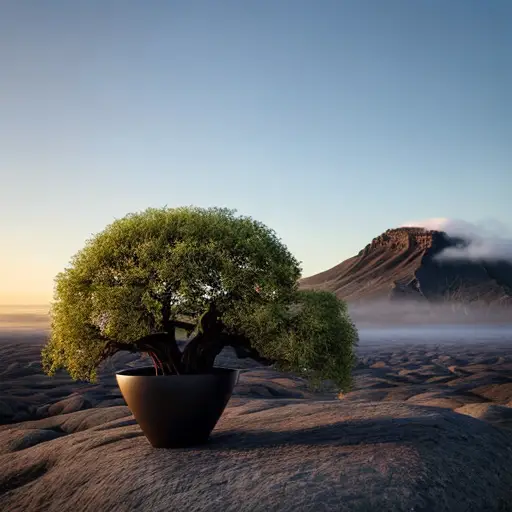Well, well, well, let's dive into the fascinating world of environment sculpture, shall we? Now, this peculiar art form has been causing quite the stir among academic scholars, who just can't seem to agree on whether it should be considered a legitimate form of art or not. Some argue that environment sculpture is nothing more than a glorified pile of junk, while others see it as a groundbreaking expression of creativity. The debate stems from the fact that these sculptures often incorporate unconventional materials and are created in unconventional spaces, challenging the traditional notions of what constitutes art. But hey, who needs a stuffy old definition of art anyway? Let's embrace the chaos and appreciate the audacity of environment sculpture, shall we?
One interesting fact about why environmental sculpture is debated as a form of art by academic scholars is that it challenges traditional notions of art and its relationship to the environment. Unlike traditional sculptures that are confined to galleries or museums, environmental sculptures are often large-scale installations created in natural or urban landscapes. This blurring of boundaries between art and nature raises questions about the purpose, permanence, and commercialization of art, leading to debates among scholars about its classification as a true art form. Some argue that environmental sculptures are ephemeral and temporary, as they are subject to natural decay or human intervention, while others contend that their integration with the environment enhances their artistic value. This ongoing debate highlights the evolving nature of art and the need to redefine its boundaries in response to contemporary artistic practices.
Ah, the never-ending debate surrounding environment sculpture! Academic scholars just can't seem to agree on whether it should be considered a legitimate form of art or simply a practical endeavor. On one side of the argument, you have those who believe that environment sculpture lacks the necessary artistic merit, dismissing it as nothing more than an elaborate construction project. They argue that the focus should be on aesthetics and conceptual depth, rather than the practicality of the sculpture. On the other side, you have those who champion the innovative nature of environment sculpture, praising its ability to transform spaces and engage viewers in a unique way. They argue that the practicality of the sculpture is precisely what makes it art, as it challenges traditional boundaries and pushes the limits of creativity. So, the debate rages on, leaving us to ponder the delicate balance between artistic expression and practicality in the world of environment sculpture.

The debate surrounding environment sculpture goes beyond its artistic merits and delves into the realm of environmental impact and ethical considerations. Academic scholars often question the sustainability of these large-scale installations, as they often require significant resources and materials. Critics argue that environment sculpture can contribute to environmental degradation, as the construction process may involve deforestation, excessive energy consumption, and the use of non-recyclable materials. This raises concerns about the long-term ecological footprint of such artworks.
On the other hand, proponents of environment sculpture argue that it can serve as a catalyst for environmental awareness and change. They believe that these installations can be designed with sustainability in mind, utilizing recycled or repurposed materials, incorporating renewable energy sources, and even promoting ecological restoration. By engaging viewers in a thought-provoking and immersive experience, environment sculpture can raise awareness about environmental issues and inspire individuals to take action.
However, the ethical considerations surrounding environment sculpture extend beyond its environmental impact. Some scholars question the appropriation of public spaces and the potential displacement of local communities that may occur during the installation process. They argue that these sculptures can disrupt the social fabric of a community and prioritize the artistic vision over the needs and voices of the people who inhabit the space.
In conclusion, the debate surrounding environment sculpture as a form of art by academic scholars encompasses not only its artistic merits but also its environmental impact and ethical considerations. While some argue that the sustainability and ethical concerns outweigh the artistic value, others believe that environment sculpture can be a powerful tool for environmental awareness and social change. Striking a balance between artistic expression, environmental responsibility, and ethical considerations is crucial in assessing the true value and impact of environment sculpture in our society.
Fun fact: The debate surrounding environmental sculpture as a form of art among academic scholars stems from its unconventional nature and the challenges it poses to traditional artistic concepts. While some argue that environmental sculptures blur the boundaries between art and nature, others contend that they lack permanence and are subject to the ever-changing natural elements. This ongoing debate adds an exciting layer of discourse to the art world, encouraging artists and scholars to explore new frontiers and question established norms.
The classification of environment sculpture as art is a hotly debated topic among academic scholars, with arguments on both sides of the spectrum. Those in favor of its classification argue that environment sculpture embodies the core principles of artistic expression, pushing the boundaries of creativity and challenging traditional notions of what constitutes art. They highlight the immersive and transformative nature of these installations, which engage viewers on a sensory and emotional level. On the other hand, skeptics question whether environment sculpture meets the criteria of art, arguing that its focus on the physical environment and practicality detracts from the aesthetic and conceptual aspects typically associated with traditional art forms. They contend that environment sculpture may be better classified as a form of design or architecture, rather than art. Ultimately, the debate surrounding environment sculpture as a form of art reflects the ongoing evolution and redefinition of artistic boundaries in contemporary society.